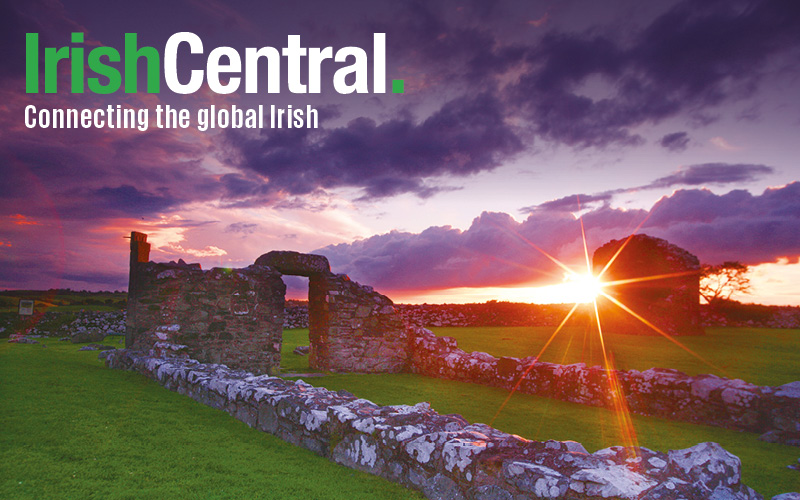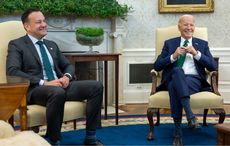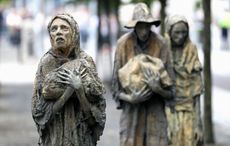PHOTOS - Hillary and Bill Clinton's trips to Ireland
In January 1992, on a cold and damp Monday evening, about two dozen Irish Americans met in Fitzpatrick’s Manhattan hotel to create a new organization, Irish Americans for Clinton.
The Clinton in question was a governor of Arkansas who was then considered a long shot for the presidency and even the Democratic nomination for the presidency.
The gathering, addressed by former Congressman Bruce Morrison, hero of the Morrison visa battle to give the Irish undocumented visas, heard there was to be an ethnic fundraiser for Clinton a month later at the Sheraton Hotel. They hardly seemed impressed.
At the fundraiser itself the new group scraped together just one table partly made up of visiting Irish students.
Ciaran Staunton, now President of the Irish Lobby for Immigration Reform, was at the dinner and remembers, “Everyone we called was too busy or gave Clinton no chance. It was very tough going. Nowadays a few hundred I’ve met claimed they were there.”
The fledgling candidate stopped by the table and seemed delighted he had an Irish following.
But Chris Hyland, Clinton’s outreach person on ethnic affairs, was deeply disappointed in the Irish turnout and let it be known. It seemed the Irish had hit another roadblock when it came to coalescing around a presidential candidate.
The dream since Famine times had been to engage an American president on the side of Ireland, not the British. But the Atlantic alliance and special relationship between the US and Britain had proven far too durable a kinship to crack.
Maverick politicians who evinced sympathy for Irish nationalists, such as now-Congressman Peter King, were untouchable. In a bizarre moment, King, then an elected official, was told by the secret service that he could not meet President Reagan during a visit to Long Island in the early 1980s.
[[quote: “The dream since Famine times had been to engage an American president on the side of Ireland.”, pos:left]]
It seemed an even longer shot that the isolation could be breached in 1992. After the first Iraq/Gulf war (the successful one) George Bush Senior looked unbeatable. His ratings were sky high. His interest in Irish issues was zilch. During the Bush administration, a group of Irish Americans met with a State Department official overseeing Ireland. The diplomat looked like he had barely started shaving.
He told them his Irish post was merely a function of the country being alphabetically closest to Iceland, a NATO ally and his real interest. As for Ireland, he pulled a batch of Daily Telegraph clippings from his drawer. The notoriously anti-Irish newspaper was his main source of information. The anger in the room was palpable, expressed best by Dr. Bob Linnon of the Irish American Unity Conference, who called the diplomat’s attitude “a complete disgrace.”
Outside on the sidewalk the sense of despair was evident and the need to find an alternative plan starkly clear.
Leaders in the Irish lobby knew Bush was very unlikely to press for action on Northern Ireland. They were looking for a different kind of candidate and homed in on Clinton among the Democrats.
The Irish soon discovered there was something different about Clinton. Unlike 90 percent of American politicians, he needed no staffers to hand-hold him during discussions.
His time at Oxford University during the birth of the Northern Irish Civil Rights movement in the late 1960s had placed Ireland on his radar forever. Though he was from a state without an active Irish American base, he had followed the history of The Troubles ever since attending Oxford.
He was ready when the Irish came calling.
Clinton spoke at an Irish candidate’s forum night in April 1992 and, most importantly, promised a visa to the U.S. for Sinn Fein leader Gerry Adams, then an international pariah.
Most observers shrugged at the time. Campaigning was different to governing, such a promise would never be fulfilled, they thought. A visa for Gerry Adams was a pipedream.
Later that year, in September, Irish American legend Mayo-born Paul O’Dwyer met Clinton at the Sheraton Hotel in Manhattan and came out of the meetings glowing.
O'Dwyer, former New York City Council president, had been meeting with American politicians about Ireland since the 1930s. He’d never met one like this. “He will turn the Irish issue upside down,” he predicted. He never spoke a truer word.
PHOTOS - Hillary and Bill Clinton's trips to Ireland
Once in power, Clinton overturned 200 years of British oversight on American policy towards Ireland.
Urged on by a group of Irish American leaders who were intermediaries with Sinn Fein, Clinton jumped on board the Irish bandwagon. The State Department spluttered. Tom Foley, the Anglophile Speaker of the House, objected strongly.
But Clinton, the consumate politician saw something. In January 1994, after a titanic struggle between pro-British and pro-Irish forces, the decision on whether to give Gerry Adams a visa landed on Clinton’s desk.
On the night he had to make the decision he was sandwiched at a dinner between Speaker Foley and Secretary of State Warren Christopher. Both men pounded him on reasons why Adams should not be given a visa.
Clinton, however, was not for turning. Despite the advice of the FBI, CIA, State Department and the British, on January 31, 1994 he gave a visa to Gerry Adams. In the end the key counterweight was Senator Edward Kennedy, who had decided the Sinn Fein peace outreach was for real.
Clinton’s campaign promise had been fulfilled, and all hell broke loose.
John Major refused to take his calls and the British media lambasted him for it, calling it the greatest insult ever offered a British government. In America, of the major newspapers only The New York Times approved.
Adams arrived amid a welter of excitement. He spoke at the Waldorf Astoria at an event hosted by Irish American business leader William Flynn and he went on Larry King Live, forcing British authorities to ban the show in Britain.
The Adams move was one of the key triggers that brought about the historic August 1994 IRA ceasefire. The American president’s unorthodox, outside the box maneuver had played a massive role in bringing an end to the violence in Northern Ireland.
To activist Irish organizations, Bill Clinton was a hero and his wife Hillary was not far behind. On their first visit to Ireland, in December 1995, they were feted and celebrated in Belfast, Derry and Dublin like no one since JFK. Even the British admitted their mistake in opposing the visa.
Maureen Dowd, in the New York Times, wrote that Clinton’s Belfast speech before hundreds of thousands was the highlight of his presidency.
During his impeachment battle the Irish were first to the ramparts. On September 11, 1998, when news of the impeachment effort broke, there was an Irish event at the White House presenting him with the Paul O’Dwyer Memorial award. The media turned up in droves, expecting the conservative Irish attendees to sit on their hands at least when Clinton appeared.
Instead he got a hero’s welcome on the South Lawn, standing ovation after standing ovation. Clinton later remarked it meant a tremendous amount to him in his hour of trial. A deep and permanent bond had been established.
Hillary too became a committed Irish peace activist. She hosted teas for women from deprived nationalist and loyalist areas. Her Vital Voices conferences gave voice to female leaders from the North, who had never been heard before. She was soon on first name terms with Irish leaders of every stripe.
Down the long years Hillary gathered a tight group of Irish American supporters around her. One of her last visits as Secretary of State was to Belfast, where she practically pleaded to stay involved post-State.
Ireland and the successes there have meant much to the Clintons, almost as much as they have meant to the American Irish activists, who see in Bill the first American president to step up for their cause. Hillary also has a large share of the reflected glory, which she will no doubt draw on in the 2016 campaign if she runs.
Prominent New York lawyer and lobbyist Brian O’Dwyer, who sits on the boards of both the Emerald Isle Immigration Center and the Irish American Democrats (and is the son of the late Paul O’Dwyer), believes that support is firmly in place. “There will be a decision, probably sometime at the end of this year, and I think everybody is really hoping she does it. It’s a personal decision, so it’s up to her if she wants to, but I think we’re all very excited about the prospect.
“The country needs, above anything else, a very competent manager, and she has the experience to be a terrific manager as well as an inspirational figure. I know [her announcement to run] would be well-received, certainly among the Democratic faithful, who are really hoping she will, and of course by Irish America because there is nobody like the Clintons, who have kept the cause of Ireland at the forefront like that.”
What started very modestly on a rainy night in Manhattan back in 1992 at Fitzpatrick’s Hotel culminated in the greening of a US president in a way no one had ever thought possible. His wife now could take advantage of that relationship too if she decides to run.




Comments